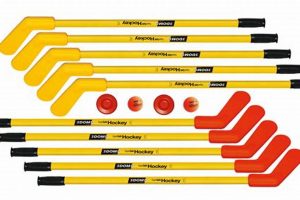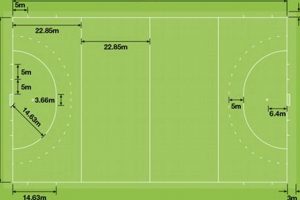Structured, repetitive exercises designed to improve specific skills and techniques in the sport are fundamental to athlete development. These activities are essential for enhancing performance and ensuring consistent execution of fundamental movements during gameplay. For example, a short corner routine practiced repeatedly allows players to refine their timing, positioning, and passing accuracy.
The implementation of these targeted training sessions offers several advantages. They contribute to improved player proficiency, increased team cohesion, and a reduced risk of injuries. Historically, their use has been integral to the progression of the sport, enabling coaches to impart tactical strategies and refine the physical capabilities of athletes. The strategic application of these techniques is vital for competitive success.
The subsequent discussion will address various categories of these exercises, encompassing skill development, tactical awareness, and physical conditioning. Consideration will be given to exercises focusing on passing accuracy, shooting power, defensive positioning, and cardiovascular endurance. The aim is to provide a comprehensive resource for coaches and players seeking to enhance their capabilities in the sport.
Enhancing Performance Through Strategic Training
The following provides guidance on optimizing focused training to achieve desired results, applicable across various skill levels.
Tip 1: Emphasize Fundamental Skill Reinforcement: Exercises should prioritize correct technique. A poorly executed pass repeated numerous times reinforces improper form, hindering development.
Tip 2: Incorporate Game-Realistic Scenarios: Training activities should simulate in-game pressure and decision-making. This promotes adaptability and enhances the transfer of skills from practice to competition.
Tip 3: Maintain a Progressive Difficulty Curve: As players demonstrate proficiency, the complexity of exercises should gradually increase. This challenges athletes and prevents stagnation.
Tip 4: Integrate Interval Training for Enhanced Endurance: The inclusion of high-intensity bursts followed by periods of recovery improves cardiovascular fitness and on-field stamina.
Tip 5: Foster Active Recovery Between Sets: Light activity, such as jogging or stretching, between exercise repetitions aids in muscle recovery and reduces the risk of injury.
Tip 6: Promote Specificity of Exercise: Activities should align with positional requirements. Forwards should focus on shooting accuracy, while defenders should concentrate on tackling technique.
Tip 7: Employ Video Analysis for Enhanced Feedback: Recording and reviewing performance allows for identification of areas requiring improvement, fostering objective self-assessment.
By adhering to these principles, a structured approach to focused training will yield enhanced performance and foster player development. Consistent application of these guidelines will contribute to a competitive advantage.
The article will conclude with a discussion of the role of technology in modern training methodologies, further enhancing preparation and strategic advantage.
1. Skill Enhancement
In the context of focused training activities, skill enhancement represents the progressive improvement of fundamental abilities necessary for effective gameplay. Its achievement is predicated on the design and execution of exercises targeting specific aspects of player performance. The following facets detail the practical application of skill-focused sessions.
- Technical Proficiency Refinement
Targeted activities facilitate the refinement of core technical skills, such as stick handling, passing accuracy, and receiving technique. Repetitive drills executed under controlled conditions allow players to develop muscle memory and enhance the precision of their movements. For example, cone drills can be utilized to improve dribbling agility, while passing exercises enhance accuracy and speed of distribution.
- Tactical Awareness Development
The integration of tactical elements into skill-based exercises fosters improved decision-making and strategic thinking. Activities that simulate game scenarios, such as two-on-one breakaways or defensive pressure situations, allow players to develop their understanding of spatial awareness, positional play, and tactical positioning. These training sessions cultivate the ability to anticipate opponents’ movements and make informed decisions under pressure.
- Physical Conditioning Integration
Physical conditioning is seamlessly integrated into skill development activities, enhancing both technical capabilities and physical endurance. Interval training exercises incorporating stick work and ball control improve cardiovascular fitness and muscular endurance. For example, shuttle runs with dribbling drills combine agility training with technical skill refinement. This integrated approach maximizes training efficiency and ensures players are physically prepared for the demands of gameplay.
- Cognitive Processing Enhancement
Certain exercises designed to improve skill can also challenge cognitive processing abilities, such as reaction time, pattern recognition, and decision-making speed. Activities that require players to quickly assess a situation and respond accordingly, such as intercepting passes or reacting to unexpected changes in direction, stimulate cognitive agility. Enhanced cognitive processing translates to improved on-field awareness and faster, more effective responses to dynamic game situations.
Collectively, these facets highlight how a structured, skills-oriented practice regime directly contributes to overall player development. By emphasizing technical proficiency, tactical awareness, physical conditioning, and cognitive processing, these activities create a holistic approach to training, optimizing player performance and increasing the likelihood of success on the field.
2. Tactical Application
Tactical application within focused training refers to the practical implementation of strategic concepts and game plans through structured exercises. It represents the bridge between theoretical understanding and on-field execution, emphasizing the importance of translating tactical principles into tangible actions. The effectiveness of this application hinges on the design and execution of activities specifically tailored to reinforce strategic awareness and decision-making.
- Set Piece Execution
Set pieces, such as penalty corners and free hits, represent pivotal moments in the sport where tactical precision can directly translate into scoring opportunities. Exercises designed to refine set piece execution involve repetitive practice of pre-determined routines, focusing on aspects such as timing, positioning, and passing accuracy. For example, penalty corner routines are drilled repeatedly to ensure coordinated movement and precise shot placement. The consistent application of these routines in training enhances the likelihood of successful conversion during competitive matches.
- Pressing Strategies
Defensive pressing strategies, aimed at regaining possession in the opponent’s half, necessitate coordinated movement and tactical awareness from all team members. Exercises designed to improve pressing involve simulated game scenarios, requiring players to anticipate passing lanes, apply pressure on the ball carrier, and communicate effectively. For instance, a three-player pressing drill can be used to teach players how to trap an opponent in a specific area of the field. This proactive approach to defense can disrupt the opponent’s attack and create scoring opportunities.
- Transition Play
The ability to seamlessly transition from defense to attack, and vice versa, is a critical component of modern competitive play. Exercises focusing on transition play involve simulated turnovers, requiring players to quickly adapt their positioning and decision-making based on the changing dynamics of the game. For example, a drill where players transition from defending a simulated attack to launching a counter-attack forces them to quickly assess the situation and exploit vulnerabilities in the opponent’s defense. This emphasis on fluid transitions enhances a team’s ability to capitalize on opportunities and maintain control of the game.
- Positional Play
Effective positional play, characterized by strategic placement of players to maximize field coverage and create passing lanes, is fundamental to maintaining possession and generating scoring chances. Exercises designed to improve positional awareness involve grid-based activities where players are constrained to specific zones, forcing them to think about their positioning relative to teammates and opponents. This targeted training fosters a deeper understanding of spatial awareness and tactical positioning, enabling players to make smarter decisions and contribute more effectively to the team’s overall strategy.
These tactical elements are integrated into practice sessions, thus fostering a holistic approach to training. By emphasizing set piece execution, pressing strategies, transition play, and positional play, these activities ensure that tactical concepts are not merely theoretical ideas but rather tangible components of on-field performance. The practical application of these principles contributes to improved decision-making, enhanced strategic awareness, and a greater likelihood of success in competitive matches.
3. Physical Conditioning
Physical conditioning constitutes an indispensable element of structured exercises designed to enhance athletic capabilities in the sport. The direct correlation between an athlete’s physical preparedness and their ability to execute technical skills under pressure necessitates a deliberate integration of conditioning into practice regimens. The execution of complex passing sequences, for example, demands not only refined technical ability but also sufficient cardiovascular endurance to maintain intensity throughout prolonged periods. Therefore, exercises that simultaneously develop skill and endurance are crucial.
The implementation of targeted physical conditioning activities within exercises serves to mitigate the risk of injury and optimize performance consistency. For instance, plyometric exercises integrated into agility drills can improve explosive power, thereby enhancing a player’s ability to accelerate and decelerate quickly during gameplay. Furthermore, incorporating resistance training into core stability exercises strengthens the muscles responsible for maintaining balance and posture, reducing the likelihood of lower back injuries. These practical applications demonstrate the tangible benefits of prioritizing physical conditioning in training methodologies.
In summary, the symbiotic relationship between physical conditioning and skill-based activities is a cornerstone of effective athlete development. While technical proficiency is undeniably important, its potential is limited without the foundational support of robust physical capabilities. The strategic integration of conditioning exercises within practice sessions not only enhances performance outcomes but also contributes to the long-term health and well-being of athletes. A holistic approach that recognizes and addresses both physical and technical demands is paramount for achieving sustained success in the sport.
4. Repetitive Execution
Repetitive execution is a core component of effective focused exercises, influencing skill mastery and automaticity within gameplay. Its consistent application fosters improved performance through the reinforcement of proper technique and the development of muscle memory. Therefore, structured activities, incorporating recurrent movements, are essential for achieving competence in the sport.
- Skill Refinement Through Consistent Practice
Consistent practice reinforces proper technique and refines motor skills. For instance, repeatedly executing a specific passing sequence enhances passing accuracy and timing. Players develop a heightened sense of feel and spatial awareness, leading to more precise and consistent passing during gameplay. The act of repeating the same actions ingrains the correct motor pathways in the brain, enabling efficient execution.
- Automaticity Development
The objective of these structured practices is to develop automaticity, which is the ability to perform skills without conscious thought. A player who has achieved automaticity in their shooting technique can focus on other aspects of the game, such as positioning and player movement. For example, a forward who has consistently practiced shooting from various angles will be able to react instinctively in a scoring situation, without pausing to consider the mechanics of the shot. This skill increases reaction speed and overall effectiveness in game situations.
- Error Correction and Refinement
Repetition provides opportunities for error correction and incremental improvement. Coaches and players can identify subtle flaws in technique and make adjustments. By consistently monitoring and correcting these errors, players gradually refine their skills, leading to increased accuracy and efficiency. For example, if a player consistently misses a particular type of shot, repetitive practice can be used to isolate and correct the specific aspect of their technique that is causing the problem.
- Mental Toughness Development
The consistent application of structured activities promotes mental toughness and resilience. Overcoming the monotony of repeated drills requires discipline and focus. Players learn to persevere through fatigue and maintain their concentration, developing the mental fortitude needed to perform under pressure. For instance, repeatedly practicing penalty corners can build mental resilience, enabling players to perform consistently under the high-stakes environment of a penalty shootout.
The facets detailed illustrate the direct benefits of repetitive execution in focused training activities. From honing technical skills and cultivating automaticity to facilitating error correction and fostering mental fortitude, the consistent application of repetitive movements is foundational for optimized performance. Its strategic integration into training regimens significantly contributes to improved gameplay proficiency and competitive success.
5. Strategic Variation
Strategic variation, within the context of structured training, refers to the deliberate modification of exercises to address specific tactical objectives or to counteract predictable patterns of play. The connection between strategic variation and exercises centers on the principle that rigid adherence to identical routines can limit adaptability and hinder the development of improvisational skills necessary for competitive success. A team consistently executing the same penalty corner routine, for example, becomes predictable and therefore vulnerable to defensive countermeasures. Strategic variation mitigates this vulnerability by introducing alternative options, deceptive plays, and unexpected movements within the framework of the exercise.
The incorporation of strategic variation requires a thorough understanding of game dynamics and opponent tendencies. Coaches analyze video footage, scout opposing teams, and assess their own team’s strengths and weaknesses to identify areas where variation can provide a tactical advantage. Consider a scenario where a team consistently attacks down the right flank. Strategic variation might involve introducing crossing patterns from the left flank, utilizing overlapping runs from midfield, or implementing a decoy run to create space for a central attacker. The practical significance of this understanding lies in the ability to disrupt the opponent’s defensive structure, generate scoring opportunities, and maintain a competitive edge.
In conclusion, strategic variation is a critical component of comprehensive exercise design. It enhances adaptability, promotes improvisational skills, and provides a tactical advantage by disrupting predictable patterns of play. Its successful implementation requires a deep understanding of game dynamics, opponent tendencies, and a commitment to continuous analysis and adaptation. The deliberate integration of variation into training regimens is essential for maximizing player development and achieving sustained competitive success. The ultimate goal is to prepare athletes to react effectively to unpredictable scenarios and exploit opportunities as they arise within the dynamic context of the game.
Frequently Asked Questions
The following addresses common inquiries regarding structured exercises to enhance capabilities in this sport.
Question 1: What is the optimal duration for a training session focusing on skill acquisition?
Session duration should be determined based on player age, fitness level, and the specific skills being targeted. Shorter, more frequent sessions are often more effective than longer, less frequent sessions, particularly for younger athletes. Overly long sessions can lead to fatigue and diminished learning.
Question 2: How frequently should specific routines be incorporated into a training schedule?
The frequency of incorporating specific routines depends on the athletes’ existing skill levels and the complexity of the drills. Introducing new routines should be done gradually, allowing ample time for familiarization and practice before increasing the frequency of repetition.
Question 3: What is the role of physical conditioning within a training session?
Physical conditioning is an integral component of comprehensive sessions. Activities that enhance strength, speed, agility, and endurance should be interwoven into the training plan. Properly conditioning the body reduces the risk of injury and supports the execution of technical skills under pressure.
Question 4: How should coaches adapt drills to accommodate varying skill levels within a team?
Adaptations should be made to exercise intensity, complexity, and individual player roles to ensure all athletes are appropriately challenged. Differentiated instruction can be employed to cater to a wide range of capabilities within a single team.
Question 5: What is the recommended approach for introducing tactical elements into structured exercises?
Tactical concepts should be introduced incrementally, beginning with simple scenarios and progressing to more complex game situations. Players need a solid foundation in fundamental skills before tactical concepts are introduced to avoid overwhelming them.
Question 6: How can coaches effectively monitor player progress during training?
Observation, performance metrics, and feedback mechanisms are critical for monitoring progress. Coaches should record performance metrics, provide constructive feedback, and use video analysis to identify areas for improvement.
The answers above provide valuable insights to optimize training and skill enhancement. Consistent application of these insights will lead to improved gameplay and performance.
The following section will provide a compilation of specific activities for various skills.
Conclusion
This article has provided an exploration of drills for field hockey, emphasizing their importance in skill development, tactical awareness, and physical conditioning. The strategic implementation of exercises designed for repetitive execution and incorporating strategic variation has been shown to be crucial for maximizing athletic potential and achieving competitive success. Key principles discussed include the need for fundamental skill reinforcement, game-realistic scenarios, progressive difficulty, and integration of physical conditioning elements.
The sustained commitment to structured training, underpinned by a thorough understanding of the principles outlined herein, is essential for advancing individual and team performance. The future success of athletes and teams will depend on the ongoing dedication to refining these exercises, adapting them to evolving tactical landscapes, and leveraging technological advancements to enhance training methodologies. Continued focus on these aspects will contribute to the continued evolution and advancement of the sport.



![Indiana Field Hockey: Grow the Game in IN [2024] Your Ultimate Source for Hockey Updates, Training Guides, and Equipment Recommendations Indiana Field Hockey: Grow the Game in IN [2024] | Your Ultimate Source for Hockey Updates, Training Guides, and Equipment Recommendations](https://ssachockey.com/wp-content/uploads/2025/10/th-804-300x200.jpg)



